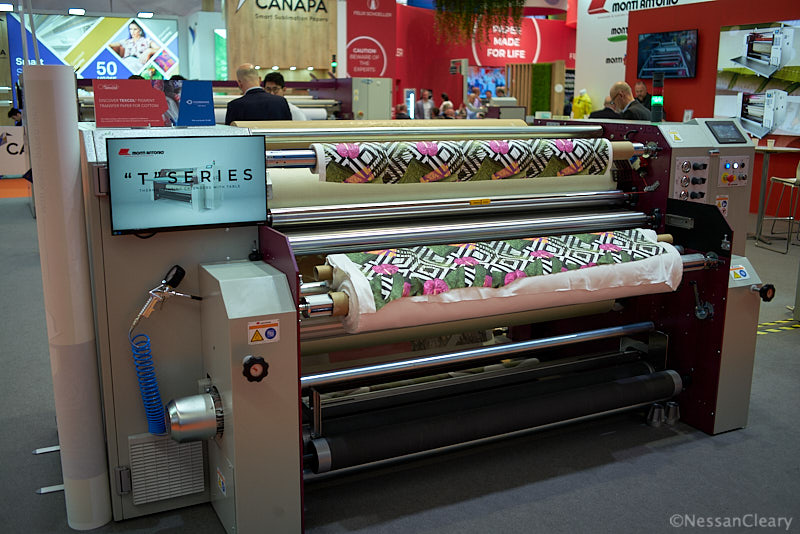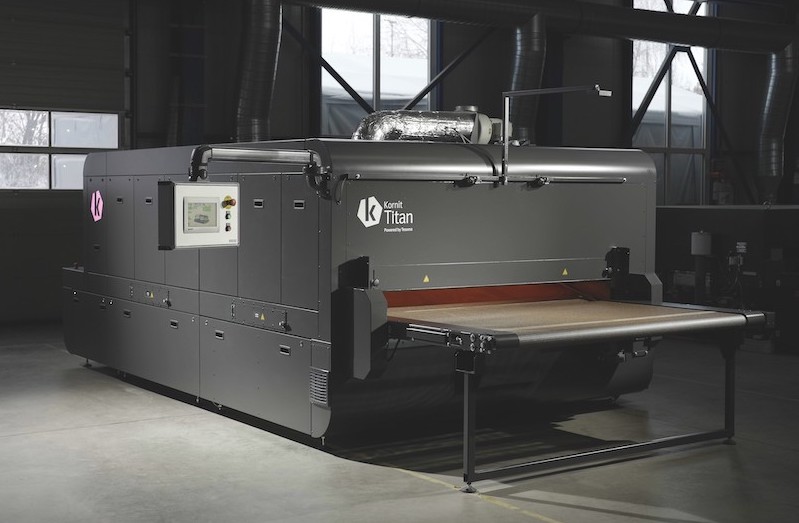Heat presses, including roll-to-roll calendars, are crucial for finishing printed textiles. Key considerations when choosing one include the ability to maintain consistent heat and pressure, matching width to your printer, and safety features. Opting for a more robust machine ensures higher quality and a longer lifespan, making it a sound long-term investment.
A great many applications now rely on printing with water-based inks and some form of heat press to cure the inks and finish the job off. Typically we focus on the printers but these heat presses are just as important to the final output and therefore to the business proposition as a whole.
There are a number of different options, depending mainly on the applications you want to work with. Turning dye sublimation transfers into printed textiles, for example, will normally require a roll-to-roll calendar. The process is simple enough; feed the printed roll of transfer paper together with the textile roll through the calendar and the combination of heat and pressure should sublimate the image from the paper to the textile, ensuring a long lasting print with good wash-fastness.
There are a number of factors to consider when choosing which calendar to invest in. Most calendar presses will use two drums with one for the heat and one for pressure. The key to these devices is the ability to maintain consistent heat and pressure across the whole width, which is where some of the cheaper machines can struggle. The size of the drums, together with the degree of consistency in their heat and pressure, will determine the production speed.
Ideally, the calendar should be able to reach up to 200ºC to activate the sublimation across a range of materials and inks. Some use oil to generate the heat while others have a heating element in the centre of the roller that is electrically powered. The degree of control over the heat will vary from one vendor to another but the more control you have the better as too much heat will damage some materials. Naturally, you want the calendar to come up to operating temperature as quickly as possible, and to maintain that temperature between jobs.
Equally, you should also look for some control over the amount of pressure so that you can set the right pressure for the material in use. They should all produce at least 6 bar of pressure for dye sublimation. Some machines will produce more pressure than others. Klieverik and Monti Antonio, for example, both sell calendars able to produce 8 bar of pressure, which is needed for some uses, such as Mimaki’s TraPis transfer system for pigment textile inks.

The width should obviously match the width of the substrates you are printing to. There is an argument for buying a slightly bigger calendar if you think you might move up to a wider printer. This only really applies if you have a 1.1m or 1.3m wide printer, with many dye sublimation printers typically being around 1.6m wide, though some vendors also sell machines up to 1.9m wide. The wider the calendar press, the more it will cost, because it will require more heavy-duty engineering to maintain the heat and pressure across that width. That is especially true of the bigger, 3.2m wide calendars.
That said, the basic requirements won’t change so these devices won’t become obsolete. It is definitely better to choose the dye sublimation printer and calendar together but any competent dealer should be able to advise on the best fit between these devices. The more robust the machine, the better the quality of the final prints, which will also ensure that it lasts many years so it is best to choose the right size of both printer and calendar to start with.
You might be tempted to consider using an infrared heater built in to the press to cure the ink instead of a calendar. This is a good option for exhibition graphics but won’t produce the sort of quality that many other textile applications require, including garments and home furnishings. Only a heat press can deliver the true sublimation needed to create the more vibrant colours and wash-fastness that most consumers expect.
The main alternative to a roll-fed calendar is a flat heat press though these are limited to much smaller sizes. These are widely used for Direct-to-Garment and Direct-to-Film as well as flat applications such as ceramic tiles and photo panels. They can give more consistent pressure performance but the heating may not be evenly distributed.
Dye sublimation can also be used to decorate other objects. However, for this you will need a heat press designed to cope with the shape of each particular object. The most obvious example is mugs, where the heat press will come with clamps that wrap around the mug to create the heat and pressure necessary to sublimate the image from the transfer paper to the mug. Ideally you will want a press that can be adjusted to hold different sizes, and where the pressure can be adjusted depending on the object, such as mug or glassware. That said, the most important consideration is the even distribution of the heating elements around the item, as this will affect the longevity of the print. So the trick is to have a degree of sizing flexibility but without compromising the heat distribution or pressure control.
Dye sublimation is only suitable for polyester and blends thereof. For other substrates a heat tunnel might be more suitable. These give good all round drying and in some cases also cure the inks but without damaging the material.
Some inks require more time than others, though the latest DtG inks do cure very quickly. There’s a huge choice in terms of sizing so its a question of matching the heat and dwell time needed for the inks, with the degree of productivity required. They can be expensive but a good heat tunnel should be able to handle the output from several printers, vastly improving the overall productivity.

Finally, it’s worth noting that any kind of heat press can be dangerous so pay attention to the overall ease of use, how intuitive it is, and ensure that it has sensors for automatic shut off and stop buttons within easy reach. All of these features will help to reduce the cost of training new operators, as well as eliminating the risk of accidents.In conclusion, these devices will last for many years so as well as the initial price you should also consider the running cost. As a general rule, anything that involves heat means potentially high energy consumption.